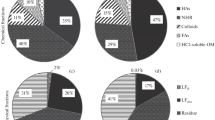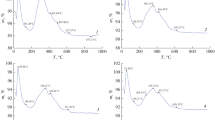Abstract
The study of labile humic substances of typical chernozems under different land uses in Kursk oblast with the help of thermal method attests to their complex composition with participation of aliphatic and cyclic structures heterogeneous in terms of their thermal stainability. According to the Z coefficient (the ratio between weight losses in the low-temperature (<400°С) and high-temperature region (>400°С)) equal to 1.10, aliphatic compounds predominate over cyclic benzenoid compounds in the composition of labile humic substances of virgin chernozems. Under the impact of permanent cultivation of winter wheat and corn, the mineralization of the aliphatic part of labile humic substances increases, and the Z coefficient decreases to 0.81–0.96. The most intense mineralization of aliphatic fragments of labile humic substances occurs under the impact of permanent black fallow, where the Z coefficient decreases to 0.76, and inert cyclic components clearly predominate in the composition of labile humic substances. In 23 years after the conversion of the permanent black fallow into the overgrown unmanaged fallow, the composition of the labile humic substances of the typical chernozem has not undergone significant changes, though a tendency for an increase in the role of aliphatic structures has been noted.

Similar content being viewed by others
REFERENCES
Z. S. Artem’eva, Organic Matter and Granulometric System of Soil (GEOS, Moscow, 2010) [in Russian].
Z. S. Artem’eva and N. P. Kirillova, “The role of organomineral products in the aggregation and humus formation in the main types of soils in the center of the Russian Plain” Byull. Pochv. Inst. im. V.V. Dokuchaeva, No. 90, 73–95 (2017).
S. L. Belopukhov, S. A. Starykh, A. N. Kupriyanov, and M. V. Grigor’eva, “The study of qualitative composition of humic acids in soddy podzolic soil by thermal analysis,” Prirodoobustroistvo, No. 3, 36–45 (2020).
A. G. Kaluzhskii, N. P. Masyutenko, and M. N. Masyutenko, “Spatial variability of the content and composition of labile humic substances in ordinary chernozem depending on slope aspect, agrogenic factors, and their relationships with microbial biomass,” Vestn. Kursk. Gos. S-kh. Akad., No. 4, 36–40 (2013).
M. Kershens, “Importance of humus content for soil fertility and nitrogen cycle,” Pochvovedenie, No. 10, 122–131 (1992).
V. I. Kiryushin, Agronomic Soil Science (Kolos, Moscow, 2010) [in Russian].
B. M. Kogut, “Transformation of humus status in Cultivated Chernozems,” Eurasian Soil Sci. 31(7), 721–728 (1998).
B. M. Kogut and L. Yu. Bulkina, “Comparative assessment of the methods for determination of labile forms of chernozem humus,” Pochvovedenie, No. 4, 143–145 (1987).
N. L. Kurachenko and S. V. Aleksandrova, “Mobile humic substances in the spatial variability of the aggregate level of the structural organization of chernozems,” Vestn. Krasnoyarsk. Gos. Agrar. Univ., No. 8 (71), 29–34 (2012).
E. A. Lykova, N. N. Miroshnichenko, O. S. Panasenko, and O. P. Syabruk, “Labile organic matter as a factor of mobilization–immobilization of trace elements in soil,” Pochvoved. Agrokhim., No. 1 (50), 256–965 (2013).
V. G. Mamontov, Z. S. Artem’eva, V. I. Lazarev, L. P. Rodionova, V. A. Krylov, and R. R. Akhmedzyanova, “Comparative characteristics of the properties of virgin, arable, and fallow ordinary chernozem in Kursk oblast,” Byull. Pochv. Inst. im. V.V. Dokuchaeva, No. 101, 182–201 (2020).
V. G. Mamontov, R. A. Afanas’ev, and E. L. Sokolovskaya, “Labile humic substances as a special group of organic compounds of ordinary chernozem,” Plodorodie, No. 5 (104), 15–19 (2018).
D. S. Orlov, Humic Acids of Soil (Moscow State Univ., Moscow, 1974) [in Russian].
Guide for the Analysis of Organic Matter during Agricultural Use and Intensive Cultivation of Soils, Ed. by K. V. D’yakonova (All-Union Lenin Academy of Agricultural Sciences, Moscow, 1984) [in Russian].
V. M. Semenov and B. M. Kogut, Soil Organic Matter (GEOS, Moscow, 2015) [in Russian].
D. A. Sokolov, I. I. Dmitrevskaya, N. B. Pautova, T. N. Lebedeva, V. A. Chernikov, and V. M. Semenov, “A study of soil organic matter stability using derivatography and long-term incubation methods,” Eurasian Soil Sci. 54, 487–498 (2021).
N. A. Titova and B. M. Kogut, “Transformation of organic matter during agricultural use of soils,” Itogi Nauki Tekh., Ser.: Pochvoved. Agrokhim. 8, (1991).
V. D. Tikhova and M. P. Sartakov, “Thermal characteristics of humic acids in peat of the Middle Ob region,” Vestn. Krasnoyarsk. Gos. Agrar. Univ., No. 11, 26–29 (2009).
L. S. Travnikova, Organomineral Interactions: Role in Pedogenesis, Their Fertility, and Resistance to Degradation (Dokuchaev Soil Science Inst., Moscow, 2012) [in Russian].
L. S. Travnikova and M. Sh. Shaimukhametov, “Products of organo-mineral interaction and soil tolerance towards degradation,” in Modern Problems in Soil Science (Dokuchaev Soil Science Inst., Moscow, 2000), pp. 356–368.
V. A. Kholodov, Yu. R. Farkhodov, N. V. Yaroslavtseva, A. Yu. Aydiev, V. I. Lazarev, B. S. Ilyin, A. L. Ivanov, and N. A. Kulikova, “Thermolabile and thermostable organic matter of chernozems under different land uses,” Eurasian Soil Sci. 53, 1066–1078 (2020). https://doi.org/10.1134/S1064229320080086
V. A. Chernikov, “Dynamics of soil humus compounds in a long-term stationary experiment of the Timiryazev Agricultural Academy,” Plodorodie, No. 4 (7), 34–36 (2002).
V. A. Chernikov and V. A. Konchits, “Kinetics of pyrolysis of fulvocompounds in some soil types,” Izv. Timiryazevsk. S-kh. Akad., No. 1, 125–137 (2002).
V. A. Chernikov and V. A. Konchits, “The composition and properties of humic acids of chernozem with various degrees of dispersion,” Pochvovedenie, No. 12, 84–88 (1978).
S. N. Chukov, Influence of Anthropogenic Impact on Structural and Functional Parameters of Soil Organic Matter (St. Petersburg State Univ., St. Petersburg, 2001) [in Russian].
S. N. Chukov, E. D. Lodygin, and E. V. Abakumov, “Application of 13C NMR spectroscopy to the study of soil organic matter: a review of publications,” Eurasian Soil Sci. 51, 889–900 (2018). https://doi.org/10.1134/S1064229318080021
M. Sh. Shaimukhametov, N. A. Titova, L. S. Travnikova, and E. M. Labinets, “Use of physical fractionation methods for the analysis of soil organic matter,” Pochvovedenie, No. 8, 131–141 (1984).
M. Sh. Shaimukhametov and E. A. Shurygina, “Thermographic and IR spectroscopic characteristics of the products of the interaction of humic acids with iron and aluminum hydroxides and silicic acid,” Pochvovedenie, No. 4, 59–72 (1980).
L. K. Shevtsova, “The program and methods for study of the humus state of soils in long-term experiments of the Geonet reference plots and polygons of agroecological monitoring,” in Influence of Long-Term Use of Fertilizers on Soil Organic Matter (Pryanishnikov Institute of Agrochemistry, Moscow, 2010), pp. 309–350.
L. K. Shevtsova, V. A. Chernikov, V. G. Sychev, M. V. Belichenko, O. V. Rukhovich, and O. I. Ivanova, “The influence of prolonged use of fertilizers on the composition, properties, and structural characteristics of humic acids in the main types of soils, Part 1,” Agrokhimiya, No. 10, 3–15 (2019).
Z. Artemyeva, N. Danchenko, Yu. Kolyagin, N. Kirillova, and B. Kogut, “Chemical structure of soil organic matter and its role in aggregate formation in haplic chernozem under the contrasting land use variants,” Catena 204, 105403 (2021). https://doi.org/10.1016/j.catena.2021.105403
M. Giovanela, J. S. Crespo, M. Antunes, D. S. Adametti, A. N. Fernandes, A. Barison, C. W. P da Silva, R. G. M. Motelica-Heino, and M. M. D. Sierra, “Chemical and spectroscopic characterization of humic acids extracted from the bottom sediments of a Brazilian subtropical microbasin,” J. Mol. Struct. 981 (1–3), 111–119 (2010).
J. Kucerik, M. S. Demyan, and C. Siewert, “Practical application of thermogra-vimetry in soil science. Part 4. Relationship between clay, organic carbon and organic matter contents,” J. Therm. Anal. Calorim. 123, 2441–2450 (2016). https://doi.org/10.1007/s10973-015-5141-8
J. Lehmann and M. Kleber, “The contentious nature of soil organic matter,” Nature 528, 60–68 (2015).
M. V. Lützow, I. Kögel-Knabner, K. Ekschmitt, E. Matzner, G. Guggenberger, B. Marschner, and H. Flessa, “Stabilization of organic matter in temperate soils: mechanisms and their relevance under different soil conditions—a review,” Eur. J. Soil Sci. 57, 426–445 (2006). https://doi.org/10.1111/j.1365-2389.2006.00809.x
R. Pallasser, B. Minasny, and A. B. McBratney, “Soil carbon determination by thermogravimetrics,” PeerJ. 1, e6 (2013). https://peerj.com/articles/6.pdf.
E. Saljnikov, D. Cakmak, and S. Rahimgdieva, “Soil organic matter stability as affected by land management in steppe ecosystem,” in Soil Processes and Current Trends in Quality Assessment (InTechOpen, London, 2013), Ch. 10, pp. 269–310. https://doi.org/10.5772/53557
C. Siewert, M. S. Demyan, and J. Kučerík, “Interrelations between soil respiration and its thermal stability,” J. Therm. Anal. Calorim. 110 (1), 413–419 (2012). https://doi.org/10.1007/s10973-011-2099-z
M. Wander, “Soil organic matter fractions and their relevance to soil function,” in Soil Organic Matter in Sustainable Agriculture, Ed. F. Magdoff and R. R. Weil (CRC Press, Boca Raton, FL, 2004), pp. 67–102.
Author information
Authors and Affiliations
Corresponding author
Ethics declarations
The authors declare that they have no conflicts of interest.
Additional information
Translated by D. Konyushkov
Rights and permissions
About this article
Cite this article
Krylov, V.A., Mamontov, V.G. The Impact of Different Cenoses on the Thermal Characteristics of Labile Humic Substances of Typical Chernozem in Kursk Oblast. Eurasian Soil Sc. 55, 452–459 (2022). https://doi.org/10.1134/S1064229322040111
Received:
Revised:
Accepted:
Published:
Issue Date:
DOI: https://doi.org/10.1134/S1064229322040111




